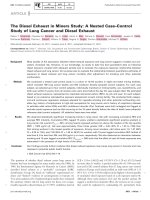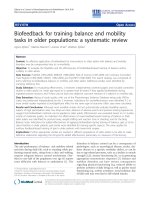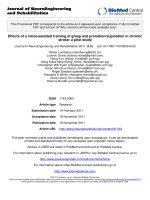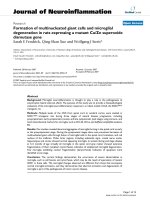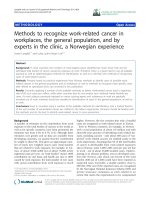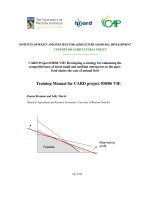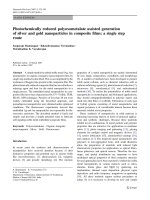Software developers’ capabilities and entrepreneurial intention in ICT industry: A Vietnamese case
Bạn đang xem bản rút gọn của tài liệu. Xem và tải ngay bản đầy đủ của tài liệu tại đây (1.22 MB, 90 trang )
A Thesis for the Degree of Master
Software Developers’ Capabilities and
Entrepreneurial Intention in ICT Industry:
A Vietnamese Case
By
Doan Thi Thanh Hien
Department of Management Information Systems
Graduate School
GYEONGSANG NATIONAL UNIVERSITY
August, 2018
Software Developer’s Capabilities and
Entrepreneurial Intention in ICT Industry:
A Vietnamese Case
A Thesis Submitted to the Faculty of the Graduate School
of the Gyeongsang National University
By DOAN THI THANH HIEN
In partial fulfillment of the requirements
for the degree
of Master in Management Information Systems
August, 2018
Prof. Sung Eui Cho, Thesis Supervisor
Approved by the Committees of the Graduate School
of Gyeongsang National University in Partial Fulfillment
of the requirements for the degree
of Master of Business Administration
Dissertation Committee:
Chairperson
Date:
.
.
Division of Management Information Systems
Graduate School
GYEONGSANG NATIONAL UNIVERSITY
ACKNOWLEDGMENTS
I came to Korean to study Master in the department of Management Information systems
from 2 years ago. For me in this time, studying in other country is interesting experience but also
difficult for me. To this time, if it were not for the unconditional love, generosity, support and
guidance from many people, I most certainly would not be the happy, optimistic, and confident
person I am today. Undertaking this Master in the department of Management Information systems
means a great deal to me. While I cannot individually thank everyone in this small part, I want
each of him or her to know that they have and continue to teach and inspire me on a daily basis.
Firstly, I would like to express my sincere gratitude to my advisor Prof. Sung Eui Cho for the
continuous support of my Master study and related research, for his patience, motivation, and
immense knowledge. His guidance helped me in all the time of research and writing of my thesis
and papers. I could not have imagined having a better advisor and mentor for my Master study.
Secondly, I must express my gratitude to all professors in my department: Prof. Han-Seong
Yoon, Prof DaeYul Jeong, Prof. Dong Hee Yoo, Prof Jong Hwan Sub and Prof. Buyng-Huyk Ahn.
Thank you for presenting a great lectures, all great suggestions and advices with tons of helpful
and academic knowledge for me and other students.
Thirdly, I would like to thank all friends in Korean, my labmates and my classmates who
together share time, knowledge with me. Their friendliness makes me feeling as I stayed at home.
Especially, I am very grateful to Dr. Motahareh Zarefard who strongly assists me in my study as
well as in all of my difficulties when staying in Korea. Her prompt inspirations, timely suggestions
with kindness, enthusiasm and dynamism have enabled me to complete my papers and thesis.
Thank you for being my teacher, friend and my older sister.
Last but not least, I owe my special thanks to my parents and my family who always stay by
my side all my life. Thank you for being so patient to me, for never giving up on me no matter
what happens. Especially, I want to thanks two important people in my life, it is my mother- Prof.
Dinh Ngoc Lan and my husband. I feel a deep sense of gratitude and admire to my mother who
was spend all her life for me and formed part of my vision and taught me the good things that
really matter in life. The lectures of my mother still provide persistent inspiration for my journey
in this life. I love my mother and thank her so much. Finally, I must express my gratitude to my
husband Mr Nguyen Duc Quang who always support and encouragement me in my life and my
work also.
Doan Thi Thanh Hien
CONTENTS
ABSTRACT
I.
Introduction .......................................................................................................................... 1
II. Background........................................................................................................................... 3
1. Literature review.............................................................................................................. 4
1.1. Software developer’s capabilities............................................................................ 4
1.2. Entrepreneurial intention (EI) ................................................................................ 5
2. Developing proportions ................................................................................................... 8
3. Research model .............................................................................................................. 28
III.
Empirical study ................................................................................................................ 29
1. Data collection ................................................................................................................ 29
2. Measurement model development ................................................................................ 34
IV.
Result of Analysis ............................................................................................................. 36
1. Reliability and validity................................................................................................... 37
1.1. Exploratory factor analysis (EFA)........................................................................ 39
1.2. Confirmatory factor analysis (CFA) .................................................................... 41
2. Test of structure model .................................................................................................. 44
3. Hypotheses test ............................................................................................................... 46
4. Comparison model test .................................................................................................. 50
V.
Summary of the Results................................................................................................... 53
1. Discussions and conclusions .......................................................................................... 54
2. Limitations ..................................................................................................................... 56
3. Future research .............................................................................................................. 57
REFERENCES ........................................................................................................................... 58
APPENDIX I .............................................................................................................................. 73
APPENDIX II ............................................................................................................................. 78
LIST OF TABLES
Table 1: Summary of definition .................................................................................................. 8
Table 2: Profile of respondents ................................................................................................. 30
Table 3: KMO and Bartlett's Test ............................................................................................ 39
Table 4: Exploratory Factor Analysis for independent variables ......................................... 40
Table 5: Obtained of Confirmatory Factor Analysis( CFA) .................................................. 42
Table 6: Confirmatory Factor Analysis (CFA) ....................................................................... 43
Table 7: Correlations ................................................................................................................. 45
Table 8: Overall model fit.......................................................................................................... 46
Table 9: Hypothesis test results ................................................................................................ 48
Table 10: Analysis result of comparison model ....................................................................... 51
LIST OF FIGURES
Figure 1: Research model .......................................................................................................... 29
Figure 2: Result of analysis ....................................................................................................... 48
Figure 3: Result of comparison model without mediating factor .......................................... 51
Figure 4: Result of comparison model with entrepreneurial self-efficacy ............................ 52
Figure 5: Result of comparison model with entrepreneurial motivation .............................. 52
ABSTRACT
This study investigates the relationship between entrepreneurs’ capabilities and start-up
intentions in software industries particularly focusing on software developers’ capabilities. For
this study, five factors of technical skills, industry knowledge, creativity, cooperation and
communication, benchmarking reflecting software developer's capabilities were adopted as
independent variables. In addition, two factors of entrepreneurial self- efficacy and entrepreneurial
motivation were adopted as mediating factors in the relationship between independent factors and
start-up intention. Data were collected from entrepreneurs and employees in software developing
companies in northern Vietnam and analyzed through structural equation modeling (SEM) to
examine the relationship. Results showed the significance of software developers’ capabilities for
the development of entrepreneurial intentions through the mediating factors. The results also
revealed that benchmarking does not necessarily lead to entrepreneurial intention due to the
important role of entrepreneurial self-efficacy.
Key words: software developer's capabilities; entrepreneurial intention; entrepreneurial
motivation; entrepreneurial self-efficacy; technical skills; industry knowledge; creativity;
cooperation and communication; benchmarking.
I.
Introduction
Entrepreneurship is a process by which individuals pursue opportunities to run their own
business or to have creative ideas inside the organization where they work. It plays a vital role in
new business creation, expansion of existing business as well as social and economic development.
Entrepreneurial activities create job opportunities, increase competitiveness and boost economic
growth (Linan et al.2008). For example in 2010, there were 248,824 active enterprises in Vietnam.
Thousands of new firms were established and millions of entrepreneurs attempted to start their
own business venture to catch the new wave of economic growth. With this rocket development
of private business, entrepreneurship has contributed approximately 40% of GDP to the economy.
And one of the most central problems of
entrepreneurship research is the definition of
entrepreneurial behavior and Delmar (1996) said this is because it is inter-related to so many social
science fields (economics, history, psychology, sociology, geography) and with each coming with
a definition that suits it. The word “ENTREPRENEUR” has its origin during the 17 th and 18th
century in the French economics (Dees, 1998). And Watson had scientifically explained
entrepreneurship by evaluating the nature of economics and commerce and posited a question “if
entrepreneurs are born or made?” He expressed his opinion that an enterprise is an economic
building block that enables an individual to undertake an economic activity. Thus, an entrepreneur
can be described as that individual that manages, takes and seeks opportunity and assumes risk in
the enterprise (Watson). Having mentioned that entrepreneurial opportunities are said to be
enormous and individuals just need to recognize them only, if they are willing to exploit them.
Obviously, entrepreneurship research has gotten to a level where the intention of individuals or as
a team should become an important thing and in addition, the study of entrepreneurial intention is
important to entrepreneurship and firm creation.
1
Entrepreneurship is very important, but finding a goal and opportunities are the first things
must be done for entrepreneurship. In fact that, this time is a gold time to have business
opportunities in IT industry when more aspects of our lives become reliant on computer software,
researchers and businessman also regard information technology (IT) as a competitive tool in a
business environment. In IT industry, there are many areas that can be mentioned and researched,
however, focusing research on human especially developers will bring the more positive effects.
Nowadays, there is an ever-growing demand for software developers. In some parts of the world,
the actual numbers of software developer vacancies are expected to rise by up to 30% by the year
2020, according to Computerworld. In fact, in IT and software industry, Software developers are
responsible for designing the computer programmes and operating systems that we use in everyday
life. From word processors, games and websites, software developers are the people that design
these systems so we can use them easily and more efficiently. As a software developer in the early
stages of a career, much of role will be focussed on the design, maintenance, and implementation
of technology. As the career develops, developers will move away from many of the day to day
aspects towards project management and strategic roles as employees of the company. Software
developers will then support the company when integrating the software into a business. After that,
they will provide ongoing management support and recommend system updates.
We know that IT is a core ingredient of nearly any part of our everyday life. Many studies
in the past have tried to tell about the entrepreneurial intention factors and processes that become
entrepreneurs, also they have attempted to understand the role of IT in business, and more
researchers are paying attention to the notion of IT capabilities, including developer's capabilities,
entrepreneurial capability, and administration capability in business. However, there are few
works that have investigated how software employees especially software developer can become
entrepreneurs in their business. Moreover, software developer of research has considered a vast
2
number of factors that affect project outcomes, from process and tools to programming languages
and requirement elicitation. They rarely give consideration but only to one of the most
fundamental components of a software developer. Specifically, what makes a software developer
great? This basic question is at the foundation of nearly every part of our world’s rapidly growing
software ecosystem: employers want to hire and retain great developers, universities want to train
great developers, and young developers want to become great entrepreneurs in the future. And yet
our understanding of what characteristics define software developer expertise still lacks specificity,
breadth, and rigor. In general, for these reasons, we are involved in trying to seek answers to these
problems. Specifically, identifying how is the relationship between software developer's
capabilities and entrepreneurial intention in ICT industry.
The paper would love to bring essential knowledge to researchers and practitioners in IT field.
Moreover, it could bring a more open minded view for businessman and developers in
understanding the new way of success. The experiment is done in Vietnam, an opening economy,
a developing country and a potential place for IT companies so this study will make new
opportunities for people who want to try in the both areas IT and entrepreneurship. The rest of this
research will be as follows. First, the paper will provide theoretical background, including
software developer’s capabilities related information and the basic theory of research model. After
that, the paper would like to present research framework of the effect of software developer’s
capabilities on entrepreneurial intention before discussing research method. Finally, the results
will be concluded and discussed together with research limitations and future expected
investigations.
II.
Background
3
1. Literature review
1.1.
Software developer’s capabilities
Everything in today’s world revolved around technology and firms are confronting an everchanging and increasingly complex environment. The software that companies utilize to manage
their business operations is becoming more of a source of competitive advantage. The ability to
be able to analyze significant amounts of data quickly and efficiently to provide the business with
information and management systems can save time and help spot sales opportunities. For some
sectors, this type of software is integral to operations. You know that app you love on your phone?
That computer game that kept you transfixed for hours as a middle schooner. That program helps
you budget and track expenditures? Software developers created all of them. According to the
Bureau of Labor Statistics (BLS), software developers are the creative, brainstorming geniuses
behind computer programs. A software developer defined as a person who performs some or all
of feasibility studies, software project planning, requirements elicitation and analysis, high-level
design, detailed program design, coding, testing, debugging, documentation, implementation, and
maintenance of commercially oriented information systems (Bekesi, 1997:7). While some
software developers may focus on a specific program or app, others create giant networks or
underlying systems that help trigger and run other programs, other, entrepreneurs who can know
or do not know how to run or develop IT products in IT market. Which means that to succeed in
today’s hyper-competitive environment with the growing power of technology, industry and
society we need IT developers and entrepreneurs who have necessary capabilities for the business
process. The concept of capability has been deemed relevant over the years, which can be attested
by its adoption in varied domains. In terms of Information technology and software, besides the
capabilities of leaders, the capabilities of developer are very important. The individual capability
has been found to be the most significant determinant of performance among software developers
(Brooks, 1987; Rasch and Tosi, 1992).
4
The prior researchers identified programming capabilities as well as human capabilities, like
the ‘ability to work with others’. Bock—Google’s vice president of people operations—indicated
that a software developer’s ability to learn on the job was critical, also claiming that human
judgment, inspiration, motivation, and creativity were more important than technical knowledge.
Similarly, McConnell argued that effective developers, in addition to technical skills, had various
personality traits like being humble about their creativity, and communication capability. Lee and
Han studied skill requirements for entry-level programmers/analysts. They found that application
development, software, social and business skills were highly valued, and recommended that
knowledge of technological trends, knowledge of business functions and general problem solving
skills are taken into programs of future Information Systems (IS)/Information Technology (IT).
(Lethbridge, 2000) found that a decreased level of importance is being place on continuous
mathematics and basic science and those new areas of emphasis, such as web-related skills, are
emerging. (Fang, Lee and Koh, 2005) found that personal/interpersonal skills like creativity were
more important than core IT skills and organizational knowledge. Conversely, Abraham et al.
found that technical skills were the most desired in new hires. They also reported that these
technical skills were more likely to be outsourced and that the skills associated with the “business
content” found in IS curricula were more likely to retain in IT major. (Kim ,2006) found that soft
skills like management, communication and cooperation should be given more emphasis in IS/IT
curricula.
1.2.
Entrepreneurial intention (EI)
5
The classical approaches assume that the business spirit is the key to individual prosperity.
The classics were less preoccupied by what can be considered psychological stimuli for starting a
business, assuming that the individual interest and, eventually, the exogenous innovation capacity
was enough. They did not say anything about the individual characteristics, the influence of the
family, the type of education or about other factors that were much later discussed by Ludwig von
Mises in Human Action and subsequently in the behavioral approaches of some authors, such as
Herbert Simon, Vernon Smith or Robert Shiller. The entrepreneurial intentions of an individual
can defined as his or her alleged desire to start a business or to form a new organization in the
future (Gartner, 1988). Current analyses regarding entrepreneurial intentions focused on at least
two important directions. The Theory of Planned Behavior (Ajzen, 1982) and the Model of
Entrepreneurial Event (Shapero, A., 1982) have been found to be both robust to empirical tests
and to converge toward a similar interpretation of the determinants of the entrepreneurial intention
(Krueger, N.F, 2000). (Ajzen, 1991) considered that entrepreneurial intentions can be explained
by the individual attitudes towards behavior, by the Sustainability subjective norms and the
perception of behavioral control. Instead, Shapero and (Sokol, 8) were focused on the perception
of desirability, on the propensity to act and on the perception of feasibility. Both psychosociological analysis models underline a number of traits and perceptions of individuals that lead
them to make certain decisions favorable to entrepreneurship. Since none of the models are
exhaustive, there were efforts to combine them. One of these attempts belongs to (Krueger, 2000),
who developed a model of entrepreneurial intentions. He considered that the personal or
situational endogenous factors influence the perceived social norms and the perceived desirability,
as well as the perceived self-efficacy and perceived feasibility, which, taken together, have a clear
influence on entrepreneurial intentions.
6
Specifically, intention to start-up a business or entrepreneurial intention is defined as the
commitment to performing behavior that is necessary to physically start the business venture
(Krueger Jr, Reilly and Carsrud, 2000). Entrepreneurial intentions assumed to predict individual's
choice to found their own firms (Ajzen, 1991). Meanwhile, Krueger and Carsrud (1993) defined
the term employment status choice as the individual decision to enter an occupation as a
waged/salaried individual, or a self-employed one. In other words, it is a motivation for an
individual to become self-employed as contrast to organizational employment. Intentions are
assumed to capture the motivational factors that influence a behavior; they are indications of how
hard people are willing to try, of how much of an effort they are planning to exert, in order to
perform the behavior. In general, the greater the intention, the stronger is the motivation to engage
in entrepreneurial behavior (Ajzen, 1991). Therefore, investigating what factors determine the
entrepreneurial intention is a crucial issue in the entrepreneurship research. For instance, Raposo
(2006; 2008) found that individuals who evidence more propensities for the start-ups creation
seem to possess self-confidence and leadership capacity.
The independent variable classified in this study is software developer’s capabilities with the
components of Technical skills (TS), Industry knowledge (IK), Creativity (CR), Cooperation and
communication (CAC), Benchmarking (BM) in promoting entrepreneurship intention. The
dependent variable is the Entrepreneurial intention (EI). Entrepreneurial self-efficacy and
motivation are mediating variables. Emphasizing that the definitions used in this study primarily
adopted from previous studies and researches, this paper receives benefits from others, learns to
avoid occurred mistakes and expectedly arranges a good base for the analysis. Table 1 summarizes
the operational definitions of the variables in this study.
7
Table 1: Summary of definition
Constructs
Technical skills
Descriptions
That is skill, expertise or technical competence acquired
through training and education or learned on the job and are
specific to each work setting related to the specific field
Industry
knowledge
That is information acquired through sensory input about
foundation knowledge, entrepreneurship, market increases
an individual's or a group's capacity for effective action
Creativity
Creativity is often understood as the process to use the
ability, orientation, state of mind or set of skills to make
something new
Cooperation and
communication
The processes of transfer, exchange information and
coordination that take place between partners for agreeing
on common goals and for the coordinated achievement of
common work results among the participants.
Benchmarking
Benchmarking as a systematic approach through which
organizations can measure their performances against the
best-in-class organizations and it is a powerful and effective
tool to learn from others in order to get the excellence.
Entrepreneurial
Self-efficacy
Refers to the confidence an individual has in his or her
competencies to successfully fulfill various entrepreneurial
tasks throughout the different developmental stages of a
start-up
Entrepreneurial
motivation
Entrepreneurs’ perceptions of their own abilities and the
relevant business environment, the specific business idea,
and feeling activated, driven, incentivized, inspired by goals
of the entrepreneur
Entrepreneurial
intentions
Individual's desire and attitude to start a business or to form
a new organization in the future
2. Developing proportions
8
References
Medina, 2010;
Damooei, Maxey
and Watkins, 2008
Huber, 1991;
Nonaka, 1994;
Massad and Tucker,
2009
Cropley, 1999;
Ward, Finke, and
Smith, 1995
K. Bauknecht,
1995;
L. Suchman, 1987;
Lee and Jones,
2008
Attiany, 2009;
Leibfried and
McNair, 1992;
Besterfield, 2011
Izquierdo &
Buelens, 2011;
Zarefard & Cho,
2018; Chen, 1998;
Naktiyok, 2010
Estay, Durrieu & A
Taormina & Lao,
2007; Naffziger,
Hornsby &
Kuratko, 1994
Gartner, 1988;
Ajzen, 1991;
Krueger Jr, Reilly,
& Carsrud, 2000
Technical skills (TS)
Technical skills are defined as "those skills acquired through training and education or
learned on the job and are specific to each work setting. Technical skills are a skill, expertise or
technical competence related to the field of engineering or technology of the developer (Medina,
2010). Technical skills or ‘hard skills’ is often associated with the use of tools, equipment related
to work properly and efficiently, as well as all technical matters. It can be known and understood
more easily as can be seen clearly with the naked eye (Yahya and Muhammad Rashid, 2001).
Technical skills are skills that require a combination of specific knowledge and skills of the work
done using the body to achieve the target (Damooei, Maxey and Watkins, 2008). In the working
environment, technical skills normally refer to technical procedures or practical tasks that are
typically easy to observe, quantify, and measure. The skills are tangible, specific, and usually
teachable such as typing 50 words per minute or changing tires (Roselina, 2009). In other views,
technical skills are the ability to perform work in a technically competent manner and to monitor
it in an independent and critical manner (Mohd Fauzi, 2000). Technical skills can be acquired in
a formal and nonformal way. In a formal way, Medina (2010) explained that the common way is
through academic channels, namely through the institutions of higher learning. In addition,
attending courses and seminars organized by world bodies such as International Electrical and
Electronic Engineers (IEEE) and obtaining certification through this channel, is one of the ways
to obtain technical skills. The nonformal method is through a progressive tutorial was written,
electronic, and practical way that can be done to obtain the technical skills (Medina, 2010).
Consistent involvement is needed to improve the technical knowledge in the field of endeavor so
that skills are constantly improved.
Software developers can encounter numerous problems and difficulties in their jobs and
technical skills challenges for software developers. Software developers must have some
9
programming capability however; as the industry is consistently changing the modern codes today
may not necessarily be the same as those used yesterday. The software developer will be required
to keep ahead of the game and identify the appropriate technology for any system. Moreover,
developer's technical skills are always associated with the technological capability that is the
ability to perform any relevant technical function or volume activity within the firm including the
ability to develop new products and processes, and to operate facilities effectively (Teece, 1997).
Technological capability is becoming extremely important because responding to dynamic market
needs requires the development of new products that are increasingly nested in new technologies
(Hsieh and Tsai, 2007) and such technologies change very rapidly (Handfield and Bechtel, 2002),
thereby necessitating firms to keep abreast with this technological change. If software developers
want to become entrepreneurs they need to have well developed technological capabilities to get
high performing for firm (Lavie, Kang and Rosenkopf, 2011; McEvily, Eisenhardt and Prescott,
2004) because mastering state of the art technologies allow them to pioneer in process innovations
leading to competitive advantage through efficiency gains (Teece, 1997). They are also more
innovative (Afuah, 2002) and can achieve higher differentiation by innovating products in
response to the changing market environment (Teece and Pisano, 1994; Verona, 1999).
In terms of entrepreneurship, according to Ashley-Cotleur, King and Solomon (2009) there
are a number of individual factors that motivate a person’s decision to become an entrepreneur
including technical skills, experiences and knowledge. These factors will make some people more
self-efficacy and have more motivation than other people. Papulova and Makros (2007) find that
most entrepreneurs are technicians, require skills in the field of management and especially
technical skills seem to be lacking when it comes to business development over the long term.
Papulova (2007) recognized four areas of managerial skills imperative for entrepreneurs working
at Small and medium-sized enterprises including technical skills and others. Addition, Freel (1999)
10
identified technical skills in the workforce that impact on the successful entrepreneur. Based on
this logic, the authors formulated the following hypotheses:
H1a: Employee’s technical skills to be software developer positively affect entrepreneurial selfefficacy towards entrepreneurial intention in ICT industry
H1b: Employee’s technical skills to be software developer positively affect entrepreneurial
motivation towards entrepreneurial intention in ICT industry
Industry knowledge (IK)
There are many who argue that we are moving towards a new economy or new society, in
which the role and significance of knowledge as an input to economic processes have
fundamentally changed. In some cases, it is argued that these rests on advances in information
technology are leading to a ‘paradigm shift’. The idea here seems to be that there are basic changes
in economic functioning, and changes in the economic rules of the game, for both business and
policymakers.
However, what does it mean to speak of the 'knowledge'? At the outset, it must be say that
there is no coherent definition, let alone theoretical concept, of this term: Knowledge is
information acquired through sensory input: Reading, watching, listening, touching, etc. The
concept of knowledge refers to familiarity with information and theoretical concepts. Knowledge
can be transfer from one person to another or it can be self-acquire through observation and study.
Knowledge is also defined as the justified belief that increases an individual's or a group's capacity
for effective action (Huber, 1991; Nonaka, 1994). Knowledge can be transfer from a source to a
receiver. However, in order for effective knowledge transfer to take place, knowledge should be
expressed in a form that is "interpretable by receivers" (Alavi and Leidner, 2001). For example,
the knowledge of developers is knowledge of computer science fundamentals; object-oriented
11
programming, design patterns, algorithms and data structures, how computers work at a low level,
hardware, operating systems, networking, databases & much more stuff.
At the outset, it must be said that there is no coherent definition, let alone theoretical concept,
of this term: it is at best a widely-used metaphor, rather than a clear concept. But based on the
previous studies about knowledge, in our study, we propose that we will divide industry
knowledge into three parts including foundation knowledge, market knowledge and
entrepreneurial knowledge. Firstly, foundation knowledge of developers was mentioned above.
Secondly, when talking about market knowledge, it is about understanding the market context in
which a business operates. Capabilities in market knowledge are usually a requirement of the
leadership competencies of strategic orientation, commercial orientation, and customer impact. In
ICT industry, at basic levels of performance, developers as leaders understand obvious industry
trends, the company's products and its customers. Middle-level performers see emerging trends.
At high levels, understand relationships among the various elements of the market and see how
trends could create new customers, affect dealings with competitors and cause potentially
profitable changes. Finally, entrepreneurial knowledge speaking simply put, entrepreneurial
knowledge refers to an individual’s appreciation of the concepts, skills and mentality expected of
an entrepreneur (Jack and Anderson, 1999). Massad and Tucker (2009) articulate that this
knowledge can be acquired and developed through consistent exposure to entrepreneurship
activities. Accordingly, entrepreneurial learning is associated with the development of
entrepreneurial knowledge. Massad and Tucker (2009) identify two distinct types of
entrepreneurial knowledge that complement each other when determining new venture creation
processes. One of the two factors relates to individuals’ ability to recognize entrepreneurial
opportunities. This involves the discovery and evaluation of new venture opportunities. In fact
that, foundation knowledge about IT or software very necessary. However, studying and training
12
more about the market and entrepreneurial knowledges it would provide a platform for developers
to action, from identifying social problems (projects) in communities to finding the entrepreneurial
solution through entrepreneurial approach, from identifying competitors in market or target
market for IT projects, it is more likely that people would better appreciate the entrepreneurship
process. Linan (2004) particularly explains that exposure to the business environment makes
people more self-efficacy about their own abilities to become entrepreneurs. Moreover, Martin
(2013) found a statistically significant relationship between knowledge and skills with
entrepreneurship intention. Past studies have proposed that knowledge provides the entrepreneur
with the capacity to identify opportunities (Shane and Venkataraman, 2000). Knowledge and
experience have been well established as a factor that facilitates entrepreneurship (Ardichvili,
2003). Entrepreneurs are different from other people both in their structure of their knowledge and
the process of gathering, organizing, transferring, and using the knowledge to lead their decisions
and actions. Therefore, (Sánchez JC, 2012; Kickul J, 2009; Holcomb TR, Ireland RD, Holmes
RM, Hitt MA, 2009; Brännback M, Carsrud A, 2009,) entrepreneurial motivation enable
individuals to use the knowledge that they constructed through their experiences and social
interactions to guide their decision making and behavior in different stages of the entrepreneurship
process. In particular, for the selection to become an entrepreneur, entrepreneurship is the process
of thinking and constructing the knowledge that enables individuals to assess their abilities to
perform entrepreneurial tasks and roles and choose whether to pursue an entrepreneurial career.
Thus, the following hypotheses were formulated:
H2a: Industry knowledge positively affects entrepreneurial self-efficacy towards entrepreneurial
intention in ICT industry
13
H2b: Industry knowledge positively affects entrepreneurial motivation towards entrepreneurial
intention in ICT industry
Creativity (CR)
The global market is pushing more for cost effectiveness, strategies beyond competing with
cheap production structures are more important for western industrial companies (Goffin and
Mitchel, 2005). The capability to develop new products and bring them successfully onto the
market is generally accepted as a source of competitive advantage for companies. Creativity,
especially, creativity by individuals is important in companies.
After exhaustive research, Morgan (1953) listed the universal factor for creativity to be a
novelty (Cropley, 1999). Novelty requires originality and newness. There must be something fresh
to the idea. Sternberg and Lubert (1995) proposed that novelty must be coupled with
appropriateness for something to be considered creative. Novelty can be the coalescence of any
two or more different things or thoughts. For instance, Damien Hirst is a controversial artist who
has sliced animals into fragments, but many people do not consider this creative even though it is
novel and original. Many people do not recognize the factor of appropriateness in his work and
consider it feckless. Although creativity can be seen in the products, it can also be considered in
terms of the process. In summary, that creativity is often understood as a mental quality, ability,
orientation, state of mind or set of skills. This means that psychologists deliver the most advanced
understandings of creativity. Creativity implies novel and unconventional thinking, motivation
and persistence, the ability to work with vague and poorly defined problems, and heuristic rather
than algorithmic thinking. Creativity is studied in creative arts: music painting, literature, etc.
Many researchers have also been interested in creativity in the systems development process. They
usually consider creativity to be an important asset to a software developer but are less good at
14
specifying exactly why this should be the case. In a software developer, creativity could be
understood as a set of personal competencies, in the same way, that professional skills like object
modeling, algorithm design and experience with a particular programming language are
understood as competences. Thus a developer or project manager could understand their existing
creativity competencies and set out to improve them. Creativity competencies are concerned both
with solving problems and with recognizing opportunities. This is an important distinction.
Moreover, Ward, Finke, and Smith (1995) defined creativity in the products made the
differences in people, the pressures that motivate, and the processes behind creativity. Many
perceive individuals as "being creative" or not, citing outstanding examples such as Einstein or
Picasso as possessing uniquely creative personalities which refer to a set of personal characteristics
that uniquely influence one's cognitions, emotions, confidence (self- efficacy), motivations, and
behaviors in various situations. The products made are new and fresh which are the clearest
example of creativity. However, there are defining subtleties in people; for example, some people
are considered to be more creative than others, and in addition to inherent differences in people,
there are different motivations for creativity (e.g., some people are driven to create). Other, there
are several studies have indicated that have a relationship between self-efficacy and creativity of
individuals (Phelan and Young, 2003; Tierney and Farmer, 2002) which showed that some people
are considered to be more creative than others, they will fell more self-efficacy or confidence
about themselves. Finally, the process for creativity can be different. Some people seclude
themselves while others seek guidance and dialogue. According to Ward (2004), novel and useful
ideas are the fundamental for entrepreneurship since the ability to seek potential opportunity and
idea generation to innovate are critical attributes for an entrepreneur (Schumpeter,1934). For
instance, entrepreneurial creativity leads to self-employment which provides individuals the
platform to express their creativity and to build their own business enterprise (Feldman and Boleno,
15
2000). High level of creativity in individual shows a strong positive influence over entrepreneurial
intention (Hamidi, 2008). The more creative an individual, the more tendencies in which he or she
is involved in entrepreneurship and this is likely to influence his or her level and type of novelty
in his or her business (Koellinger, 2008). A study showed that individuals who have more ideas
generated and higher quality of ideas produced increased their entrepreneurial intention (Molaei,
2014). The ability to generate ideas is consistent with divergent thinking which leads to an increase
in the individual having divergent thinking to positively predict entrepreneurial intention
(Batchelor and Butch, 2012). Individuals with creativity in providing useful ideas towards solving
significant problems that people are willing to pay for, reflect the high value of the ideas to be
captured through entrepreneurial activities (Kavanagh and Hisrich, 2010).
Creativity, in the form of the ability to effectively generate novel solutions to relevant
problems, can be a source of significant competitive advantage, especially in rapidly changing
environments. Creativity is important to entrepreneurs because it is the first stage in the process
of innovation, providing the stimulus for opportunity discovery and new venture creation. Based
on the above discussion, we present the following hypothesis:
H3a: Creativity positively affects entrepreneurial self-efficacy towards entrepreneurial intention
in ICT industry
H3b: Creativity positively affects entrepreneurial motivation towards entrepreneurial intention in
ICT industry
Cooperation and communication (CAC)
As humans, we have several limitations that affect our capability to create almost any piece
of software. When working at high levels of abstraction—as when writing requirements, designing
software, writing code, or creating test cases—we are slow and error-prone. Consequently, we
16
must work together to complete large projects in reasonable time and have other people try to
catch our mistakes. The two most important such skills are cooperation and communication
capability needed for this situation. Based on (K. Bauknecht, 1995) we use the terms
communication and cooperation as follows:
Communication encompasses the process of transfer and exchange of information that takes
place between communication partners. If the exchange of information serves to coordinate
activities among team members, then this type of communication serves as the basis for the
coordination of processes. A lot of the time of a software developer is spent communicating with
others: with clients, peers, managers, suppliers, and others. Communication is indeed the basis of
requirements. Documentation is the most concrete example of communication. Sadly, managers
at companies often complain that engineers, even those trained at best universities, are deficient
in both written and oral communication skills. Communication is more than using a language
according to correct grammar, in writing reports or in making speeches. What is difficult is to
choose the right level of abstraction depending on the subject of discussion and the communication
partner. Modeling skills are also an important requirement for successful communication. Indeed,
since requirements-related problems are the most costly problems during software development,
and communication problems are a major source of such requirements problems, we must invest
a lot more in educating software engineers in the area of communication. There are probably
different kinds of communication techniques required to interact with peer software engineers,
with those in other disciplines, with managers, with clients, and so on. In all cases, however,
listening is an important part of communication. Certainly, good communication skills can help
one be a better team player, and reduce the communication overhead, but good communication
skills are not enough.
17


